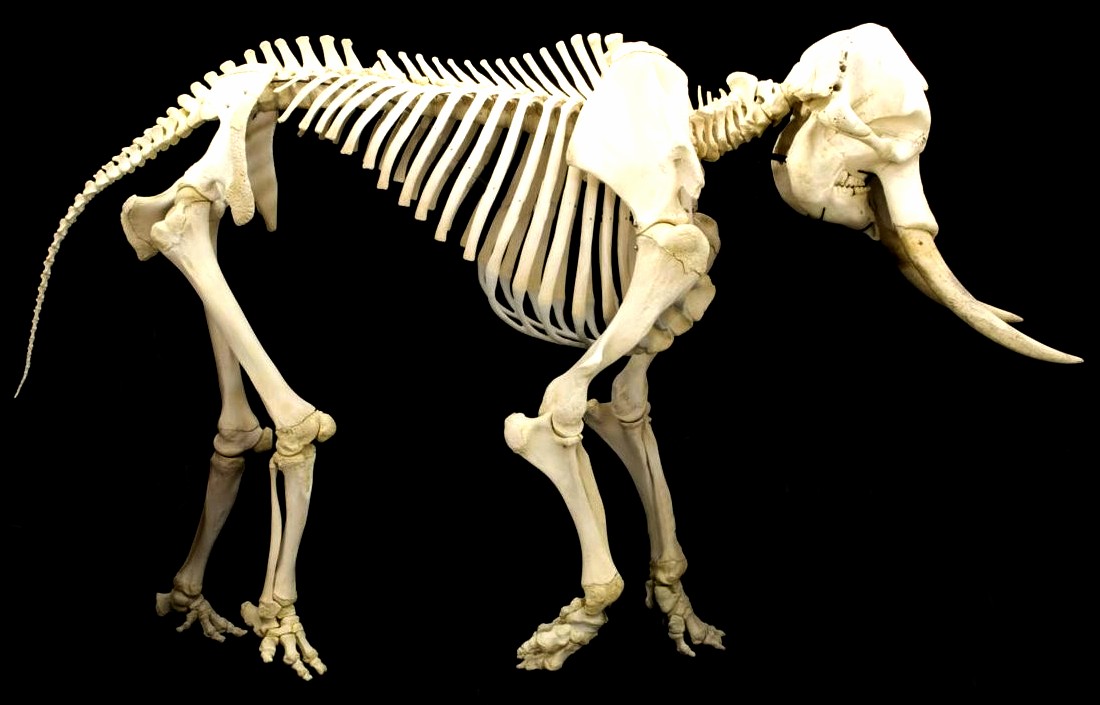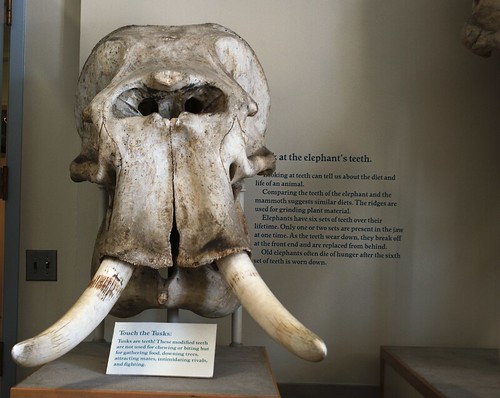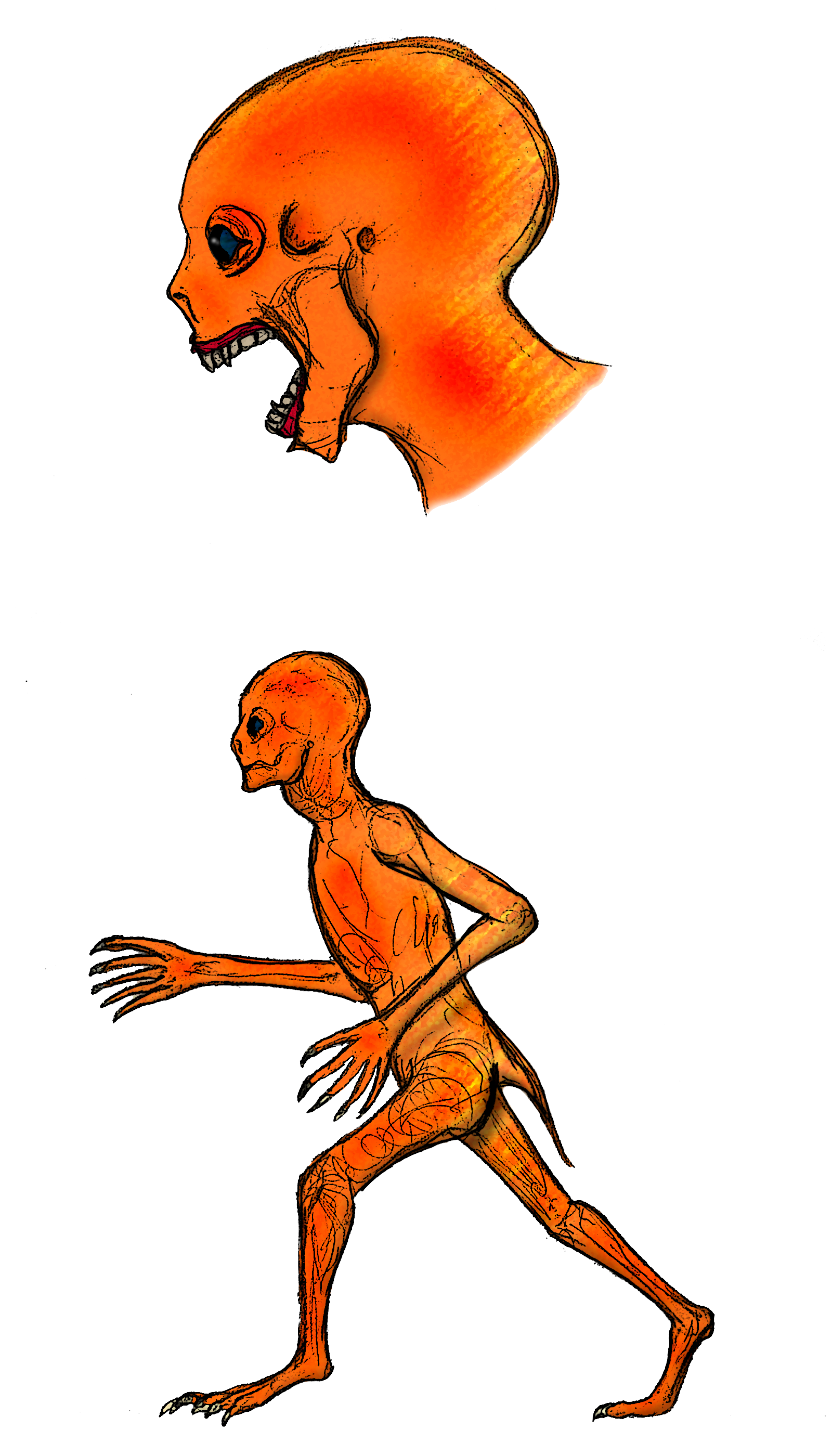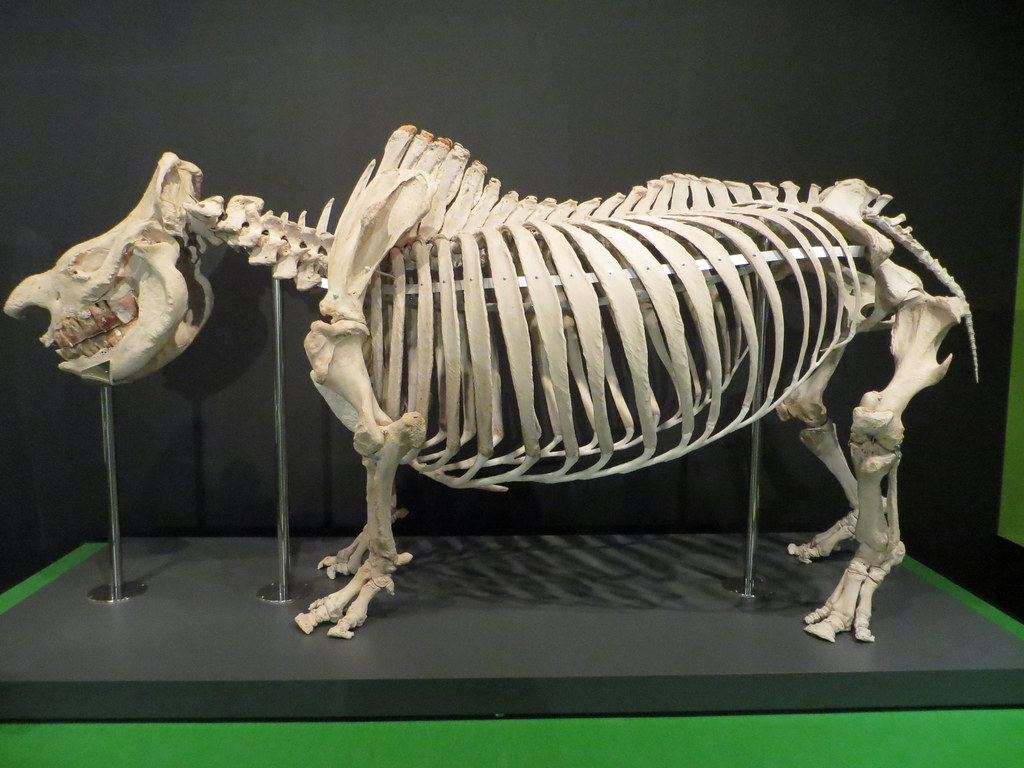|
|
Post by Infinity Blade on Oct 26, 2015 2:54:17 GMT 5
I got this game from another forum (and in a way, it's related to another thread I created). Basically, you pretend to be a paleontologist of a future species, post a picture of an animal's skeleton (or at least a portion of it) and provide an analysis of its life habits. You can even "refute" other peoples' interpretations and give your own ideas. The forum I got this from ended up with a lot of pages; I hope we can entertain ourselves for a while here too. For example and to start off: My team and I found the fossilized remains of a weird creature; here's its full skeleton and skull.   This animal's cranial morphology is very unusual. The two long forward-protruding teeth would have served as a serious obstruction when feeding, thus it must have bent down or reared up and overall put significant effort to just bite down on the food it liked to eat, a method of feeding that is very inefficient. The very short neck and very short mouth must have made feeding even more difficult. The animal appears to have had perfect binocular vision, judging from the forward-facing eye sockets at the very front of the skull. Since the eye sockets were also large, it must have had excellent vision. However, there are no signs of nostrils anywhere on the skull, so it must not have relied on scent at all. Given the excellent binocular vision, the beast must have been a predator that stabbed its prey with the two long teeth at the front. The back teeth were flat and blunt with grooves, which must have been used for crushing bones and gripping flesh respectively. The legs are long and strong, so it may have chased after prey. The large chest area allowing for a huge heart and lungs and the digitigrade stance also support the cursorial theory. |
|
Deleted
Deleted Member
Posts: 0
|
Post by Deleted on Oct 26, 2015 10:05:12 GMT 5
Our team has uncovered a mass bone bed in North America. It had over 100 well-preserved skeletons:  It appears to have relatively blunt teeth, it probably ate mainly foliage and fruits. It's hands are remarkably flexible, it is likely that it used them for grabbing. Based on the size of the eye sockets, we speculate that it may have had large eyes, possibly as an adaptation towards a nocturnal lifestyle, where the larger eyes would help collect as much light as possible. It appears to have a large cranium, and we speculate that they may have been used in intraspecific conflict, where they butt heads with a rival. Some specimens uncovered in the region between Africa and Eurasia appears to have small metal objects embedded into them. We speculate that these creatures were preyed upon by an undiscovered animal with metal teeth. No positive evidence of hair has been found as of now. Smaller relatives have been found with hair, but this species was much larger than they were, and thus would need to lose all their hair so it wouldn't overheat. We speculate that juveniles were furry, but the adults were covered completely in scales.  This is a life reconstruction of the creature, made by the palaeoartist Dragontunders:  |
|
Cross
Junior Member
  The biggest geek this side of the galaxy. Avatar is Dakotaraptor steini from Saurian.
The biggest geek this side of the galaxy. Avatar is Dakotaraptor steini from Saurian.
Posts: 266 
|
Post by Cross on Oct 26, 2015 10:47:20 GMT 5
Our team has uncovered a mass bone bed in North America. It had over 100 well-preserved skeletons:  It appears to have relatively blunt teeth, it probably ate mainly foliage and fruits. It's hands are remarkably flexible, it is likely that it used them for grabbing. Based on the size of the eye sockets, we speculate that it may have had large eyes, possibly as an adaptation towards a nocturnal lifestyle, where the larger eyes would help collect as much light as possible. It appears to have a large cranium, and we speculate that they may have been used in intraspecific conflict, where they butt heads with a rival. Some specimens uncovered in the region between Africa and Eurasia appears to have small metal objects embedded into them. We speculate that these creatures were preyed upon by an undiscovered animal with metal teeth. No positive evidence of hair has been found as of now. Smaller relatives have been found with hair, but this species was much larger than they were, and thus would need to lose all their hair so it wouldn't overheat. We speculate that juveniles were furry, but the adults were covered completely in scales.  This is a life reconstruction of the creature, made by the palaeoartist Dragontunders:  Based on the elongate neural spines along vertebrae C1 to C7, it may have had a small ridge along its neck to help with thermoregulation. |
|
|
|
Post by Infinity Blade on Oct 27, 2015 0:08:43 GMT 5
I found this fossil Holocene skull.  See the crest at the posterior end of the skull? It must have been an attachment for something. See how the face slopes downward? It must indicate a proboscis. Therefore, the crest anchored a proboscis that the creature must have used for grabbing things. The teeth are sharp, so perhaps it was a predator that grabbed and grappled with prey with its proboscis and then delivered a deadly bite. The proboscis could also have been used in feeding. |
|
|
|
Post by theropod on Oct 27, 2015 0:17:52 GMT 5
^I must strongly disagree with some of the aspects of the above description.
FEA modeling suggests that the skull shows none of the adaptions necessary for headbutting, neither is its bone exceptionately thick, nor are there any large sinuses, "trabecular bone" or other structures to dampen an impact. Instead it appears to have held a relatively large "brain cavity", though smaller than that of some of the other animals it coexisted with (such as the first new taxon described on this page, which appears to have been the most intelligent terrestrial animal of its day, based on the size of its brain).
Also the palaeoartist who produced the restoration exaggerated the length of the tail. Indeed, the caudal vertebrae of this species appear to be much shorter, and had very little, if any, mobility. However it may have anchored long filaments for display, that could have been fanned using the muscles that evidently attached to the tail. Two such animals may thus have waved their caudal regions at each other for intimidation or as a courtship ritual.
With regards to the first creature, analysis of its limb proportions is at odds with the hypothesis of it being a cursorial species. While it is true that its legs are long and digitigrade, they lack any semblance of distal elongation, and indeed appear to have been very stout. Moreover detailed examination of the anatomy of the joint surfaces, from when I and colleagues studied an associated forelimb, suggested that it was habitually held in a more collumnar posture than shown in the skeletal mount, which also doesn’t fit the cursorial hypothesis.
The anatomy of related animals makes it likely that what previous authors have identified as eye sockets are the animal’s nostrils (which in these animals seem to be the only cranial opening anterior to the orbit); since in partially related taxa the orbit seems to be unified with the temporal opening by means of a patent, but still partially present, postorbital bar. We are still trying to work out the evolutionary benefit of this arrangement, but it is in our opinion a more parsimonious explanation to assume the same was the case here, than to assume the animal lacked nostrils.
Their large size, as well as the gigantic (for a holocene animal at least) overall size of the animal, it’s robust, powerful built and probable excellent endurance suggests it was a scavenger that scared smaller, swifter predators, such as the family commonly referred to as "antelopes", from their kills and used its immensely powerful dentition to crush the bones of carcasses, including those far too large for any other carnivore.
As to the strange location of the nostrils, we are faced with a riddle that is hard to solve. Maybe future study on other members of the extinct clade vertebrata will shed more light on their functional anatomy and phylogeny.
Preliminary analyses suggest that among known vertebrates, this animal was most closely related the assemblage of highly cursorial, small to mid-sized predators bearing pointed horns or bony clubs on their heads, for which we propose to erect the new clade artiodactyla, based on the number of oddly modified toes that they all share. The interrelationship of these two with the primate clade is difficult to resolve, but they appear to be more closely related to each other than either of the three is to the older and much more well-known "reptiles".
|
|
|
|
Post by Infinity Blade on Oct 27, 2015 0:39:00 GMT 5
Maybe what were actually the nostrils had some sort of soft tissue sac that would have air blown into it, perhaps for display purposes. My team and I found a bonebed of an animal sympatric to the large toothed, air saced scavenger.  Clearly, this was a massive predator. The ribs close in on each other tightly, meaning it likely had some sort of protective carapace. The huge & robust skull, enormous & sharp canines, powerful bite, and wide gape would have made short work of many animals that lived with it. The back teeth are flat and strong, meaning they must have been used for crushing bones. The protrusions at the posterior end of the lower jaw were likely used as extra weapons in combat. The dorsal spines also indicate a sail of some sort, either for thermoregulation or display. The short, stout legs indicate that it could not run fast, turning it into a powerful, bulky ambush predator. It appears to have been a derived entelodont, given how it shares a substantial amount of physical characteristics with entelodonts. This entelodont probably evolved into an ambush hunter to elude competition with predators that helped drive its cursorial kin to extinction. In the bonebed of this beast, the individuals were found in close proximity to each other, indicating that gregarious hunting was practiced. Together, they could have overpowered and taken down anything in the ecosystem with their devastating jaws coupled with their robust, muscular, and armored bodies with dense bones. |
|
|
|
Post by Infinity Blade on Oct 27, 2015 1:15:44 GMT 5
Here's another animal I've discovered.  This beast appears to have been a humongous fossorial creature. The powerful neck and large teeth were the primary digging tools and would have been used to dig massive holes. Once a deep enough hole has been dug, the small, yet very powerful forelimbs with extremely thick cortical bone could have clawed at the sides of the hole, creating more room for its massive body. The beefy tail powered its large, powerful hindlimbs for digging its way underground. CT scans of the brain case reveal an extremely developed olfactory bulb, indicating a hyper sense of smell used to locate underground roots and tubers (although the eyes were small and gave this animal poor eyesight). This animal is known from rock sediments formed ~68 million years before the Holocene, but a few specimens have been found in Holocene strata as well, indicating this animal survived for an unusually long period of time and was thus extremely successful. |
|
|
|
Post by theropod on Oct 27, 2015 1:46:36 GMT 5
^Not to mention that the presence of steel screws and bars in the skeletons of the holocene specimens suggest that despite staying anatomically conservative, the holocene individuals had advanced to the level where they were capable of surgical alterations of each other’s skeletal structures.
|
|
|
|
Post by Infinity Blade on Oct 27, 2015 7:17:54 GMT 5
Here's an excerpt of a publication describing another Holocene denizen written by a paleontologist and his colleagues on the aforementioned other forum. Quite fascinating indeed.
|
|
|
|
Post by neogeneseamonster on Oct 27, 2015 18:47:16 GMT 5

our team found complete skeleton of enormous cetacean(an extinct group of aquatic synapsid) from holocene marine strata of North America. Although our skeleton is about 8.6m long, some isolated remains indicate this species was able to grow much larger than this; up to 30m. One interesting thing is that we found no evidence of teeth. Based on this, we predict this animal was not a predator. However, what this animal actually ate is truly mysterious. |
|
Deleted
Deleted Member
Posts: 0
|
Post by Deleted on Oct 27, 2015 20:51:21 GMT 5
futurepalaeontologist et al., 75002015, "A new genus and species of cetacean, Brachiocetus pacificus, with stomach contents and implications for cetacean diet""In the southern part of South America, we have recently uncovered a new specimen of giant cetacean, which is around half-complete. This specimen is estimated to be around ~14 meters long and over 15 tonnes in mass. The new cetacean is named Brachiocetus pacificus, where the generic name, meaning "arm whale" is derived from it's proportionally long arms, more than any other cetacean known so far. The specific name comes from it's location, near the Pacific coast of South America. It's ribcage and stomach contents are remarkably well-preserved. It shows large amounts of fish bones. We speculate that Brachiocetus may have used it's twin mandibles, which we speculate to be connected by a skin membrane, to grab fish shoals and swallow them whole." Mounted skeleton of Brachiocetus pacificus Mounted skeleton of Brachiocetus pacificus |
|
|
|
Post by Infinity Blade on Oct 27, 2015 23:52:46 GMT 5
Nonsense! Clearly, this thing used its (three?) jaws as horn-like structures for combat.
|
|
Deathadder
Junior Member
  aspiring paleontologist. theropod enthusiast.
aspiring paleontologist. theropod enthusiast.
Posts: 240 
|
Post by Deathadder on Oct 28, 2015 0:55:43 GMT 5
Yes, it would impale the hapless prey with its upper mandible.
|
|
|
|
Post by mechafire on Oct 28, 2015 6:33:52 GMT 5
 This animal was clearly adapted for an arboreal lifestyle. It's long limbs and climbs are likely affective for climbing trees. It wields large claws and sharp teeth which were probably used for tearing into wood in search of food. It has exceeding strong limbs and was indeed capable of hanging by only its hind limbs. This would have been useful for gripping small animals with both sets of front claws when eating. Although it could defend itself against some predators, it was likely nimble and quick when threatened. |
|
|
|
Post by Infinity Blade on Oct 30, 2015 3:24:31 GMT 5
  A point of interest on this animal is its skull. The nostrils are large and indicate the ability to breath in a lot of air at a time. The upper nasal bone is rugose in texture on top, indicating a presence of keratin (there is another rugose region behind the aforementioned one), probably a boss. Our team initially thought that the boss was used for headbutting, but this is unlikely, as the upper nasal bone is supported by absolutely nothing underneath. We think it was most likely used for visual display; perhaps the boss was colored. There is nothing in the anterior region of the jaw to grab food with, so we believe this beast ate with the sides of its jaws. The dorsal spines on the shoulder were tall, indicating a sail of some sort, perhaps also for visual display. The animal was robust and heavy (~1-2 tonnes) with short legs, indicating a slow-moving animal. Lacking any sort of means of defense, it would have been a defenseless, easy meal for the ambushing entelodont it lived with. |
|




















 Mounted skeleton of Brachiocetus pacificus
Mounted skeleton of Brachiocetus pacificus


